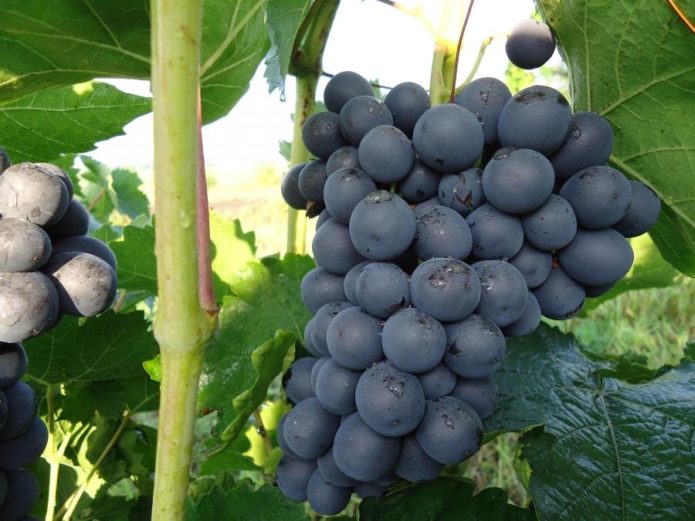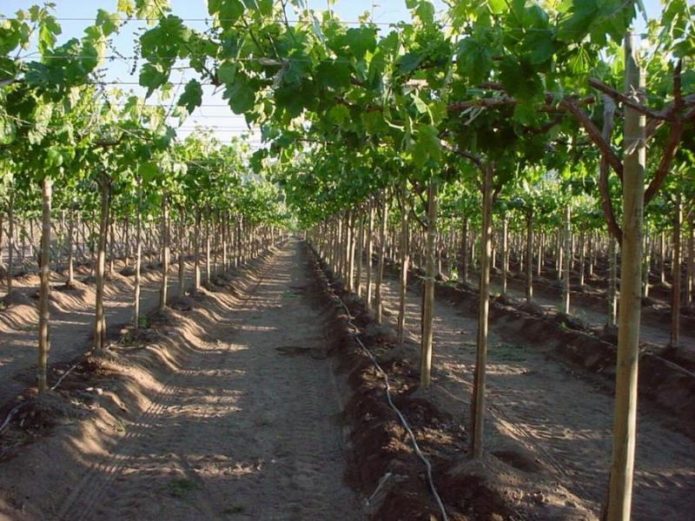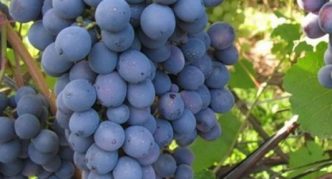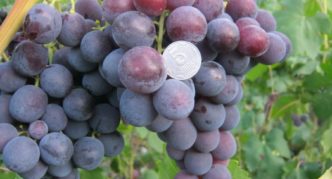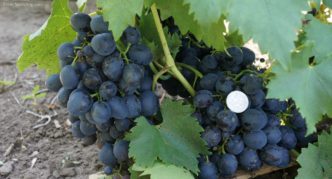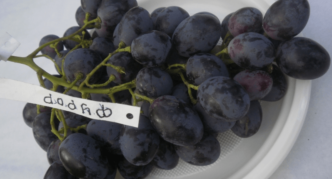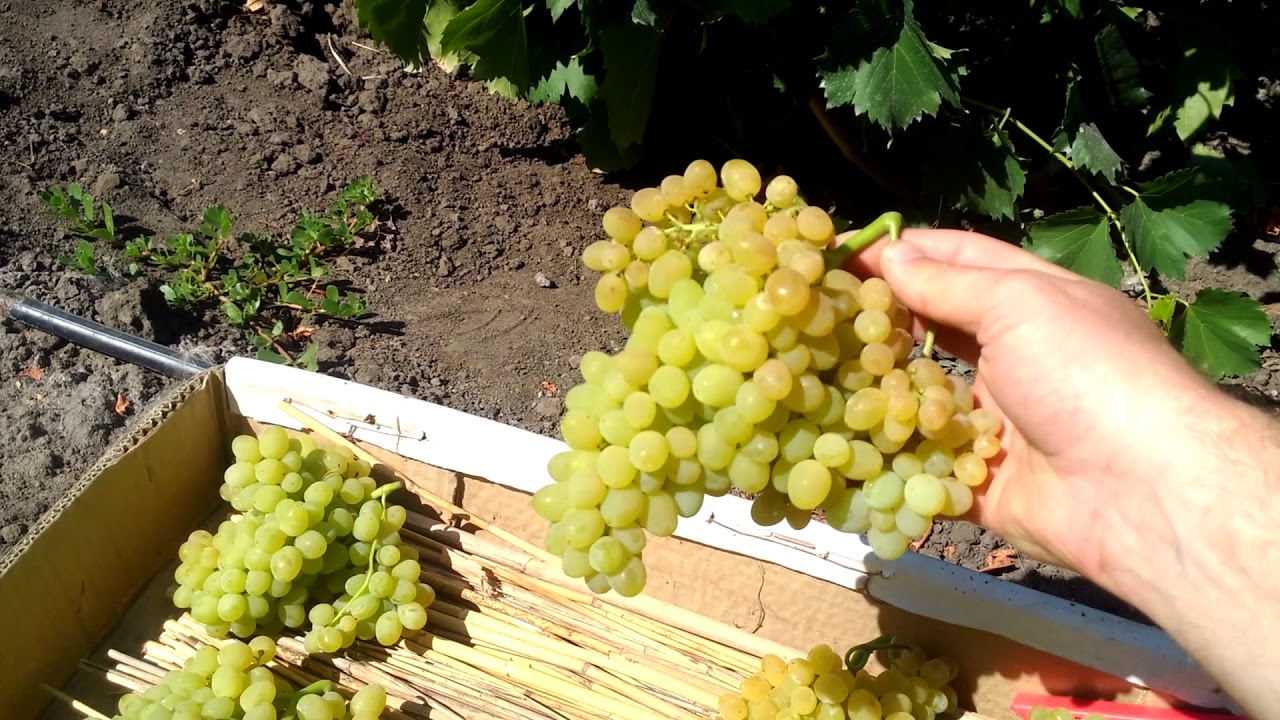Nowadays there are a huge number of grape varieties, but many of them do not tolerate cold winters in most regions of our country and do not have time to ripen during their characteristic short summer. A striking exception is Chernysh, which is able to bring a bountiful harvest even in the conditions of central Russia.
Content
The history of breeding and description of the Chernysh grape variety
Chernysh was obtained by specialists from the All-Russian Research Institute of Viticulture and Winemaking named after Ya.I. Potapenko (Novocherkassk) by crossing the Don Agate and Rusmol. Today it is not included in the State Register of Breeding Achievements. But this did not prevent the variety from gaining popularity among winegrowers in many regions of Russia, including the middle lane.
Chernysh is a table grape variety with an early ripening period. Its berries reach removable maturity within 115–120 days after bud break. In Ukraine and southern Russia, this period usually falls on late July-early August, and in more northern regions it shifts to the last days of August.
Blackie bushes are medium-sized, with a large number of shoots, of which more than 75% are fruitful. This grape variety is distinguished by good vine ripening and almost 100% rooting rate of cuttings. Plus, it blends well with most rootstocks.
Chernysh's flowers are bisexual, capable of pollinating even with a single planting. The berries are round, large, dark blue at the stage of removable ripeness. They are collected in dense, cylindro-conical, sometimes shapeless clusters weighing 500-600 g.
The pulp of this variety is fleshy, with a harmonious taste. Some growers call it simple, while others catch a peculiar aftertaste with apple or plum notes. The sugar content of ripe fruits is 16–17% with an acidity of 6–9 g / l.
Blackie easily tolerates a temperature drop down to -26aboutC and has increased resistance to mildew, mildew and gray mold. Among its disadvantages can be noted the tendency to cracking berries with excessive moisture. But damaged fruits usually heal quickly and do not rot.
Video: Chernysh grape variety review
Growing features
Despite its unpretentiousness, the Chernysh variety needs the attention of the grower. It is especially important to follow the rules of agricultural technology in regions with a cool climate, unsuitable for the cultivation of grapes.
Landing
The grapes prefer sunny, well-sheltered areas. The Chernysh variety is no exception. A place near the southern wall of a house or other building is ideal for planting it. The level of subsoil is also important.In the selected area, the depth of their occurrence should not be less than 1.5 m.
A competent choice of planting material will help not to be disappointed in the variety. Good quality seedlings should have a healthy, well-formed root system and no external damage to the ground part. It is better to buy them in nurseries and specialized stores, since it is easy to buy improperly stored seedlings or plants of the wrong variety at markets and fairs.
You can prepare planting material yourself. To do this, cut the cuttings from a healthy Blackie bush and place them in water or wet soil. Usually, after 1.5–2 months, a young plant will develop 3–4 cm long roots, after which it is ready to be transplanted into open ground.

The use of transparent containers for rooting grape cuttings allows you to observe the process of root formation
It is better to start planting Chernysh grapes in a permanent place in the spring, after stable warm weather is established, and the soil warms up to 15aboutC. In the southern regions, autumn planting is also permissible. It is carried out at least 3-4 weeks before the onset of cold weather.
A pit for planting grapes is prepared no later than 3-4 weeks before planting. When planting in spring, it is advisable to hold this event in the fall. A hole of 70 by 70 cm in size is enough for a blackie. A drainage layer 20-30 cm thick must be placed on its bottom. A mixture is poured over it, which includes:
- 2 pieces of earth taken out of the pit;
- 1 part humus or compost;
- 2 tbsp. l. superphosphate;
- shovel wood ash.
After the soil has settled, proceed directly to planting. During it, a wooden peg is installed in the center of the pit, which later serves as a support for a young plant. Next to him at an angle of 45about a seedling is placed to the surface of the earth and its roots are carefully spread. Then it is covered with earth so that the root collar remains 3-4 cm above the ground, and tied to a support with a soft rope.
Video: how to plant grapes correctly
Watering
Blackie grapes need regular watering. As a rule, it is carried out 3-4 times per season:
- in the spring, during the opening of the leaves;
- before flowering;
- during the formation of ovaries;
- after harvest.
During watering of Chernysh, about 50-60 liters of water are consumed per plant. In this case, it is necessary to ensure that moisture does not get on the green parts of the plant.
In the southern regions with a dry climate, Chernysh needs mandatory water-charging irrigation. It differs from the usual one in a large amount of water (at least 120 liters per bush). This procedure helps the grape root system to survive the winter period safely.
Too often it is not worth watering Blackie. Excess moisture can provoke the development of fungal infections and cause the berries to crack. To avoid spoilage of the crop, watering is stopped 10–20 days before the fruits ripen.
Top dressing
Blackie responds well to fertilizing with mineral and organic fertilizers. In order to increase the yield and improve the commercial quality of berries, they are applied 2-3 times per season:
- In early spring, immediately after the grapes emerge from wintering, fertilizers containing a large amount of nitrogen are embedded in the trunk circle. These include:
- Kemira-Lux;
- Nitrophoska;
- ammonium nitrate;
- urea.
- Shortly before flowering, the plants are fed with phosphorus-potassium fertilizers. A mixture of 50 g of superphosphate and 25 g of potassium sulfate is ideal for this.
- In late autumn, the trunk circle is mulched with humus. This will not only increase the fertility of the soil, but also protect the Chernysh root system from frost.
Disease and pest control
Blackie rarely suffers from dangerous fungal infections. Nevertheless, preventive treatment with fungicidal preparations (Bordeaux liquid, copper sulfate or Topaz) will not interfere with it. To obtain the effect, they are carried out at least 3 times per season:
- immediately after the start of the growing season;
- shortly before the blooming of flower buds;
- before hiding for the winter.
Of the pests, wasps and birds are the most dangerous for Blackie. They do not miss the opportunity to feast on sweet grapes. Protecting bunches from uninvited guests is fairly easy. It is enough to hide them in small mesh bags.
Pruning vines and preparing for wintering
Blackie needs mandatory pruning. Too thickened crown often causes shedding of the ovaries and a general weakening of the plant. Chernysh shows the best results when pruning vines by 6-8 eyes. But due to the high degree of fertility of the eyes located at the base of the shoot, a very short pruning (3-4 eyes) is also permissible. In this case, the total load on one bush should not exceed 45 eyes.
Vine formation is best done in the fall, after the end of the growing season. Spring pruning can lead to profuse gum flow, which is very dangerous for grapes.
In the middle lane and more northern regions, Chernysh must be covered for the winter... In late autumn, the vine is removed from the trellises, tied in bunches and laid on the ground, previously lined with branches of coniferous trees. From above it is covered with any material that allows air to pass through well.
Video: sheltering grapes with spruce branches
In the south, Chernysh can winter directly on trellises. But plants under 3 years old are best removed from the supports and bent to the ground, covered with a film or non-woven material to protect against low temperatures.
Advantages and disadvantages of Chernysh compared with similar grape varieties
Choke grapes for table use are in special demand among gardeners. But not all plants are able to grow and bear fruit in regions with cool climates. But Chernysh still has competitors.
Table: comparative characteristics of black-fruited grape varieties
| Variety name | Ripening period (time in days from leaf blooming) | Yield | Winter hardiness (° C) | Disease resistance | Average bunch weight (g) | Average weight of berries (g) | Taste (tasting score) | Sugar content (g / 100 cubic cm) |
| Donskoy agate | 116–120 | -26 | Increased resistance to mildew and gray mold. | 400–500 | 4–6 | Nice, very basic (7.7). | 13–15 | |
| Anthracite (Charlie) | 105–115 | 138.8 c / ha | -25 | Moderately affected. | 750 | 6–8 | Pleasant, harmonious, with a nightshade flavor (8.4). | 16 |
| Rochefort K | 110–120 | 173 c / ha | from -21 to -23 | It is moderately affected by diseases, very susceptible to phylloxera. | 520 | 8 | Excellent, with a pronounced nutmeg aroma (9.7). | 14,8 |
| Sphinx | 100–105 | -23 | Medium resistant to mildew and powdery mildew (3-3.5 points) | 900 | 10 | Harmonious, with a pronounced aroma. | 17–25 | |
| Furor | 105–110 | High | -24 | It is relatively resistant to mildew, oidium and gray mold. | 900 | 25–30 | Pleasant, with a subtle nutmeg aroma. | 21–23 |
| Blackie | 115–120 | 14-15 kg per plant | -26 | Increased resistance to mildew, powdery mildew and gray mold. | 500–600 | 6–8 | Harmonious (7.4). | 16–17 |
Photo gallery: grapes of various varieties
- Agate Donskoy is a time-tested grape variety that easily tolerates adverse conditions
- Anthracite is known to many winegrowers as Charlie.
- The taste of Rochefort K berries is considered a reference
- Created at the beginning of the XXI century by an amateur breeder V.V. Zagorulko the Sphinx variety has already managed to fall in love with winegrowers in Ukraine and many regions of Russia
- The size of the Furor berries is amazing
- Despite the mediocre taste of berries, the Chernysh variety is popular with winegrowers due to its unpretentiousness.
Blackie is inferior to other varieties of black-fruited grapes in taste. At the same time, only Agat Don can be compared with it in terms of resistance to diseases and low temperatures. But he also loses to Chernysh in this indicator due to the lack of immunity to powdery mildew.
Winegrowers reviews about the variety
The bush is 5 years old, and this year I amazed by the size of the bunch and berries. In the subject of Agat Donskoy, he noted his not love for the strong sun - it gets baked, I cover the bunches with old curtains - the order. The harvest was not rationed. In MU (my conditions) more than 1–2 bunches are not tied per shoot. The pollination is excellent, and the disease does not bother, although I do not miss it during treatments. Also, every year I celebrate a kind of aftertaste that I like. I consider it a problem-free variety, especially for northerners, that the berry is not very large, but so what, our people are not spoiled with grapes and rarely any of the visitors does not admire the Chernysh bunches, especially this year. And although it is still too early to reach maturity, the size and today inspires. So I can confirm that in MU, clusters and berries increase with age.
My, in my opinion, is 4 years old .... a workhorse - in any year, even if the heat, even floods, (as in this year), the Blackie will always be ... the truth ripened in the first decade of September - overloaded .. The taste of sweet cherry was only in individual berries, sugar in it really is not much, but when it lasted until October in the refrigerator, the taste became much better, small-mal cracked - 2-3 berries in a bunch ... but did not rot, there are no problems with stepchildren and ripening of the vine .. did not get under the spring frosts - woke up later ... the sores do not stick, although Potapenko's raisins were burning next to him from mildew all summer.
From my point of view, the main differences are: 1. As already noted, when the skin is cracked, it does not rot, and can hang on the bushes for a long time. 2. Taste. Agat Donskoy has grass. Chernysh has a decent one. 3. Color. Agate Donskoy with a brownish tint. Blackie is almost completely black. 4. Rooting of cuttings in the open field. Agat Donskoy has a mediocre one, Chernysh has a yield of high-grade seedlings with a powerful root system of 80 - 95%.
We have Chernysh bears fruit for the 3rd year. Its taste is simple. 2 years in a row, the berry was small, and this year the bunch is larger and denser. On the market this year they took well. 1 bush grows, but we are not going to plant more. I think this variety is not for everyone. [
Blackie is grown by many winegrowers. They highly value it for its resistance to adverse conditions and immunity to common fungal infections. However, the tendency of the berries to crack and their mediocre taste does not allow this variety to be used for industrial planting.
